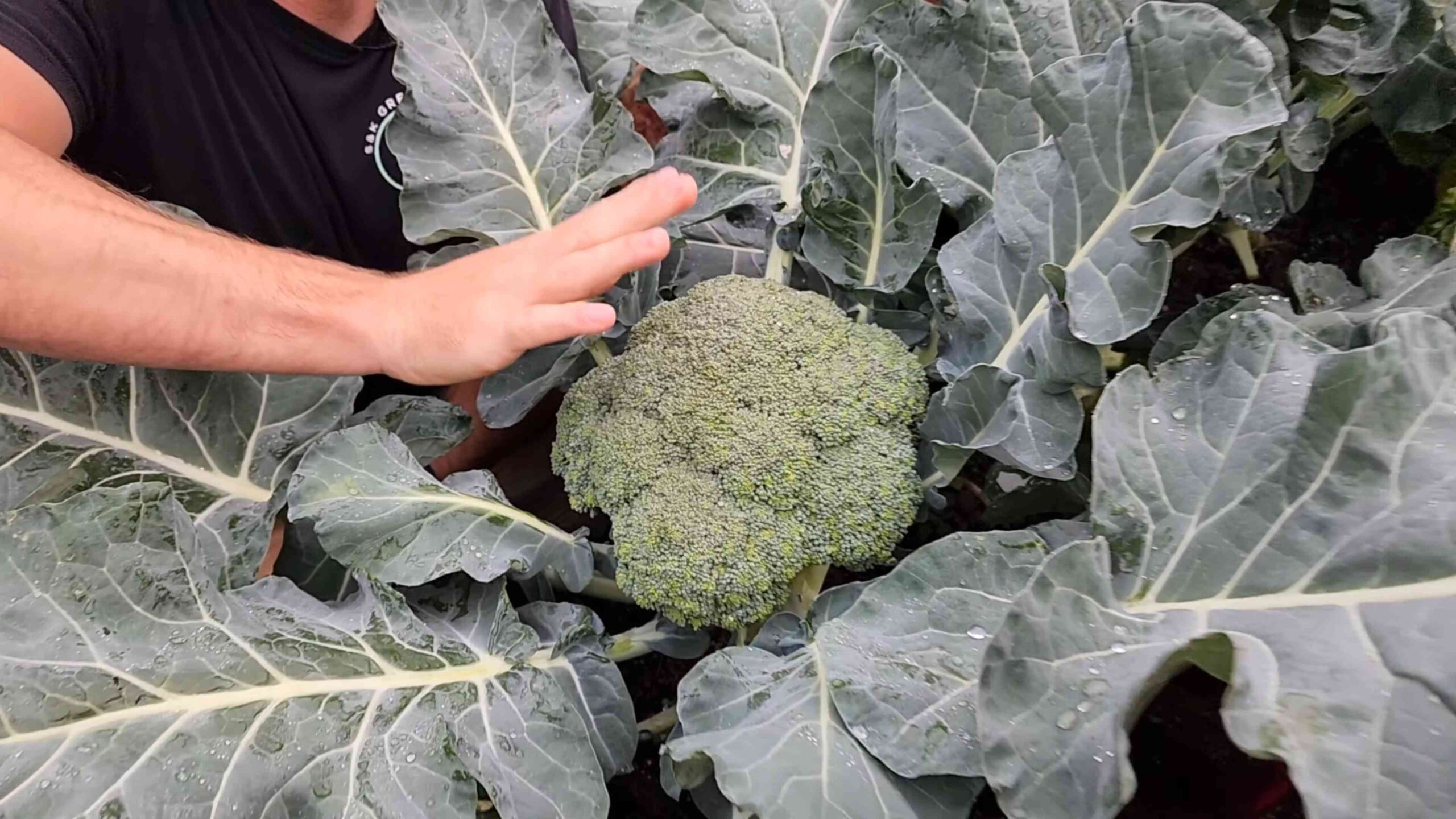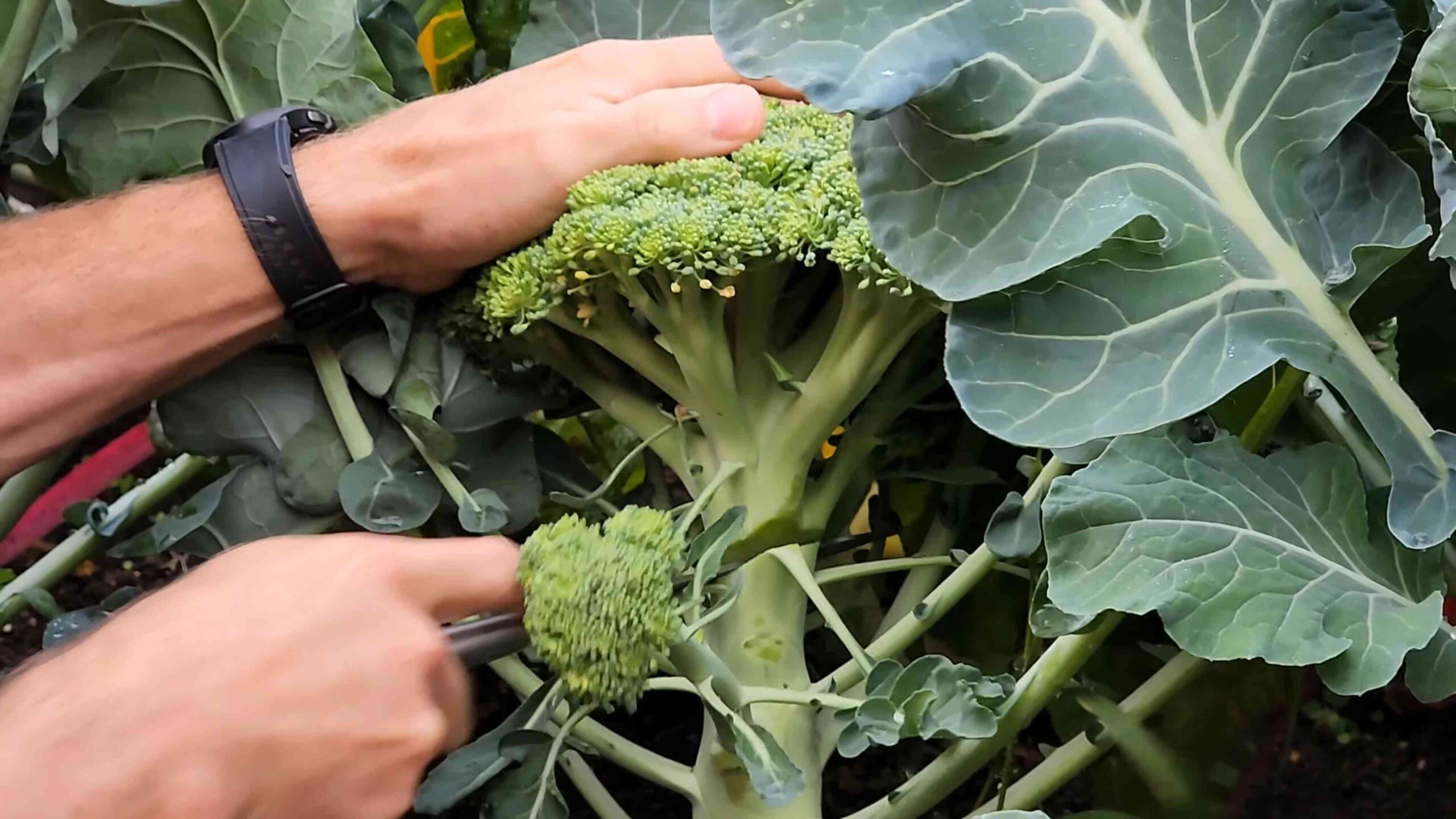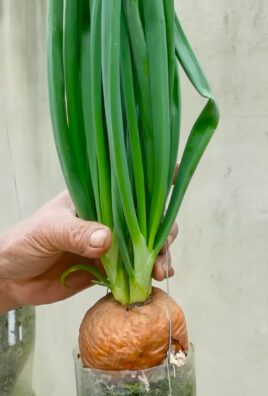Grow Broccoli at Home – sounds intimidating, right? But trust me, it’s easier than you think! Forget those pricey supermarket florets; imagine stepping into your backyard and harvesting your own crisp, delicious broccoli. This isn’t just about saving money; it’s about connecting with nature and enjoying the unparalleled flavor of homegrown goodness.
Broccoli, a member of the Brassica family, has a rich history dating back to the Roman Empire. For centuries, it was a prized vegetable, carefully cultivated for its nutritional benefits and unique taste. Today, while readily available, the joy of nurturing your own broccoli plants is a rewarding experience that brings a touch of that ancient tradition to your modern life.
Why should you learn these DIY tricks for growing broccoli at home? Well, store-bought broccoli often lacks the freshness and vibrant flavor of homegrown varieties. Plus, you have complete control over the growing process, ensuring your broccoli is free from harmful pesticides and chemicals. I’m going to share some simple, effective hacks that will help you successfully grow broccoli at home, even if you’re a complete beginner. Get ready to transform your garden (or even your balcony!) into a broccoli-producing paradise!

Grow Your Own Broccoli: A Beginner’s Guide to a Bountiful Harvest
Hey there, fellow garden enthusiasts! Ever dreamt of plucking fresh, vibrant broccoli florets straight from your backyard? Well, dream no more! Growing your own broccoli is surprisingly achievable, even for beginners. I’m going to walk you through the entire process, from seed to harvest, so you can enjoy delicious, homegrown broccoli.
Choosing the Right Broccoli Variety
Before we get our hands dirty, let’s talk broccoli varieties. There’s a whole world beyond the standard green head you see in the grocery store. Choosing the right variety for your climate and growing season is crucial for success. Here are a few popular options:
* ‘Waltham 29’: A classic, reliable variety that produces large, tight heads. It’s known for its good flavor and disease resistance.
* ‘DiCicco’: A fast-maturing variety that’s great for succession planting. It produces a main head followed by numerous side shoots, giving you a longer harvest.
* ‘Green Magic’: An early-maturing hybrid with excellent heat tolerance. This is a good choice if you live in a warmer climate.
* ‘Romanesco’: For the adventurous gardener! This variety produces stunning, fractal-shaped heads that are as beautiful as they are delicious.
* ‘Purple Sprouting’: A unique variety that produces purple florets. It’s very cold-hardy and can be harvested over a long period.
Consider your local climate and growing season when making your choice. Check seed packets or online resources for specific recommendations for your region.
Starting Broccoli Seeds Indoors (Recommended)
While you *can* direct sow broccoli seeds, I highly recommend starting them indoors. This gives them a head start and protects them from pests and harsh weather conditions, especially when they are young and vulnerable.
* Timing is Key: Start your seeds about 6-8 weeks before the last expected frost in your area. This will give the seedlings enough time to develop before transplanting them outdoors.
* Gather Your Supplies: You’ll need seed starting trays or small pots, a good quality seed starting mix, broccoli seeds, a spray bottle, and a grow light (optional, but highly recommended).
* Sowing the Seeds:
1. Moisten the seed starting mix thoroughly. It should be damp but not soggy.
2. Fill the seed starting trays or pots with the moistened mix.
3. Make a small indentation (about 1/4 inch deep) in the center of each cell or pot.
4. Place 2-3 broccoli seeds in each indentation. This increases the chances of at least one seed germinating.
5. Gently cover the seeds with the seed starting mix.
6. Lightly mist the surface with water using a spray bottle.
7. Cover the trays or pots with a clear plastic dome or plastic wrap to create a humid environment.
* Providing the Right Conditions:
1. Place the trays or pots in a warm location (around 70-75°F). A heat mat can be helpful if your home is cool.
2. Once the seeds germinate (usually within 5-10 days), remove the plastic cover.
3. Provide plenty of light. If you don’t have a sunny window, use a grow light. Keep the light a few inches above the seedlings.
4. Water regularly, keeping the soil consistently moist but not waterlogged.
* Thinning the Seedlings:
1. Once the seedlings have their first true leaves (the second set of leaves), thin them to one seedling per cell or pot.
2. Choose the strongest, healthiest-looking seedling and gently snip off the others at the soil line. Don’t pull them out, as this can disturb the roots of the remaining seedling.
* Hardening Off the Seedlings:
1. About a week before you plan to transplant the seedlings outdoors, you’ll need to “harden them off.” This process gradually acclimates them to outdoor conditions.
2. Start by placing the seedlings outdoors in a sheltered location for a few hours each day.
3. Gradually increase the amount of time they spend outdoors each day, exposing them to more sunlight and wind.
4. After a week, they should be ready to be transplanted into the garden.
Preparing the Garden Bed
Broccoli needs a sunny spot with well-drained soil. It’s a heavy feeder, so enriching the soil with compost or other organic matter is essential.
* Sunlight: Choose a location that receives at least 6 hours of direct sunlight per day.
* Soil: Broccoli prefers slightly acidic soil with a pH between 6.0 and 7.0. Amend the soil with compost, well-rotted manure, or other organic matter to improve drainage and fertility.
* Fertilizing: Incorporate a balanced fertilizer into the soil before planting. Follow the instructions on the fertilizer package.
* Spacing: Space the broccoli plants 18-24 inches apart in rows that are 24-36 inches apart. This allows for good air circulation and prevents overcrowding.
Transplanting Broccoli Seedlings
Now for the exciting part – getting those seedlings into the ground!
1. Choose a Cloudy Day: Transplanting on a cloudy day or in the late afternoon minimizes stress on the seedlings.
2. Dig the Holes: Dig holes that are slightly larger than the root balls of the seedlings.
3. Gently Remove the Seedlings: Carefully remove the seedlings from their trays or pots, being careful not to damage the roots.
4. Plant the Seedlings: Place the seedlings in the holes and gently backfill with soil. Make sure the top of the root ball is level with the surrounding soil.
5. Water Thoroughly: Water the seedlings thoroughly after planting.
6. Mulch: Apply a layer of mulch around the plants to help retain moisture, suppress weeds, and regulate soil temperature. Straw, wood chips, or shredded leaves are good options.
Caring for Your Broccoli Plants
Consistent care is key to a successful broccoli harvest.
* Watering: Water regularly, especially during dry periods. Broccoli needs consistent moisture to thrive. Aim for about 1 inch of water per week.
* Fertilizing: Side-dress the plants with a nitrogen-rich fertilizer a few weeks after transplanting. This will help promote leafy growth.
* Weeding: Keep the garden bed free of weeds, which can compete with the broccoli plants for nutrients and water.
* Pest Control: Broccoli is susceptible to several pests, including cabbage worms, aphids, and flea beetles.
* Cabbage Worms: These green caterpillars can devour broccoli leaves. Handpick them off the plants or use Bacillus thuringiensis (Bt), a natural insecticide.
* Aphids: These tiny insects suck sap from the plants, causing them to weaken. Spray them with a strong stream of water or use insecticidal soap.
* Flea Beetles: These small, jumping beetles can create tiny holes in the leaves. Cover the plants with row covers to prevent them from reaching the plants.
* Disease Prevention: Broccoli can also be affected by diseases such as clubroot and black rot.
* Clubroot: This soilborne disease causes swollen, distorted roots. Prevent it by practicing crop rotation and maintaining a soil pH above 7.0.
* Black Rot: This bacterial disease causes yellowing and browning of the leaves. Prevent it by using disease-free seeds and avoiding overhead watering.
Harvesting Your Broccoli
The moment you’ve been waiting for! Knowing when to harvest is crucial for getting the best flavor and texture.
* Timing: Harvest the broccoli head when the florets are tight and compact, before they start to open and flower. The head should be firm and green.
* Cutting: Use a sharp knife to cut the head from the plant, leaving a few inches of stem.
* Side Shoots: After harvesting the main head, the plant will often produce side shoots. These smaller florets can be harvested over several weeks, extending your harvest.
* Storage: Store broccoli in the refrigerator for up to a week. To keep it fresh, wrap it loosely in a damp paper towel and place it in a plastic bag.
Troubleshooting Common Broccoli Problems
Even with the best care, you might encounter some challenges. Here are a few common problems and how to address them:
* Small Heads: This can be caused by insufficient sunlight, poor soil fertility, or overcrowding. Make sure your plants are getting enough sunlight and nutrients, and space them properly.
* Bolting (Flowering): Bolting occurs when the plant prematurely flowers, usually due to heat stress. Choose heat-tolerant varieties and provide shade during hot weather.
* Yellowing

Conclusion
So, there you have it! Growing broccoli at home isn’t just a gardening project; it’s an investment in fresh, flavorful, and nutritious food right at your fingertips. We’ve walked you through the process, from selecting the right variety to harvesting your bounty. But why should you take the plunge and dedicate some space to this cruciferous champion?
Firstly, the taste difference is undeniable. Store-bought broccoli, while convenient, often lacks the vibrant flavor and crisp texture of freshly harvested, homegrown broccoli. Imagine the satisfaction of serving a side dish knowing you nurtured it from seed to plate. The subtle sweetness and satisfying crunch are simply unmatched.
Secondly, you have complete control over what goes into your broccoli. No need to worry about pesticides or herbicides. You can choose organic methods and ensure your family is consuming the healthiest possible produce. This peace of mind is invaluable in today’s world.
Thirdly, growing your own broccoli is incredibly rewarding. There’s something deeply satisfying about nurturing a plant from a tiny seed into a thriving vegetable. It’s a connection to nature that can be both therapeutic and educational, especially if you involve children in the process. They’ll learn about where their food comes from and develop a greater appreciation for the natural world.
But the benefits don’t stop there. Growing broccoli at home can also save you money in the long run. While there’s an initial investment in seeds, soil, and perhaps some basic gardening tools, you’ll quickly recoup those costs with the amount of broccoli you harvest. Plus, you can succession plant, ensuring a continuous supply throughout the growing season.
Now, let’s talk about variations. Don’t be afraid to experiment with different broccoli varieties. Romanesco broccoli, with its fractal florets, is a stunning addition to any garden. Purple sprouting broccoli offers a unique color and flavor profile. And broccoli raab, with its leafy greens and small florets, is a delicious alternative to traditional broccoli.
Consider companion planting to maximize your garden space and improve the health of your broccoli plants. Marigolds can deter pests, while herbs like rosemary and thyme can attract beneficial insects.
If you’re short on space, you can even grow broccoli in containers. Choose a large pot with good drainage and use a high-quality potting mix. Just be sure to provide adequate sunlight and water.
Finally, remember that gardening is a learning process. Don’t be discouraged if you encounter challenges along the way. Every gardener faces setbacks, but the key is to learn from your mistakes and keep trying.
We wholeheartedly encourage you to try growing broccoli at home. It’s a rewarding experience that will provide you with fresh, healthy, and delicious food. So, grab your seeds, prepare your soil, and get ready to enjoy the fruits (or rather, vegetables) of your labor.
Once you’ve harvested your first crop, we’d love to hear about your experience! Share your tips, successes, and challenges in the comments below. Let’s create a community of home gardeners who are passionate about growing their own food. Happy gardening!
Frequently Asked Questions (FAQ)
What is the best time of year to plant broccoli?
The best time to plant broccoli depends on your climate. In general, broccoli is a cool-season crop, meaning it thrives in temperatures between 60°F and 70°F (15°C and 21°C). For spring crops, start seeds indoors 6-8 weeks before the last expected frost. Transplant seedlings outdoors 2-3 weeks before the last frost. For fall crops, start seeds indoors in mid-summer and transplant seedlings outdoors in late summer or early fall. The goal is to have the broccoli mature before the first hard frost. Check your local extension office for specific planting dates in your area.
How much sunlight does broccoli need?
Broccoli needs at least 6 hours of direct sunlight per day to thrive. More sunlight is even better. If you’re growing broccoli indoors, use grow lights to supplement natural sunlight. Insufficient sunlight can lead to leggy plants with small heads.
What kind of soil is best for growing broccoli?
Broccoli prefers well-drained, fertile soil with a pH between 6.0 and 7.0. Amend your soil with compost or other organic matter to improve drainage and fertility. Broccoli is a heavy feeder, so it’s important to provide it with plenty of nutrients. A soil test can help you determine if your soil is lacking any essential nutrients.
How often should I water broccoli?
Broccoli needs consistent moisture to thrive. Water deeply and regularly, especially during hot, dry weather. Aim to keep the soil consistently moist but not waterlogged. Mulching around the plants can help retain moisture and suppress weeds. Check the soil moisture regularly by sticking your finger about an inch into the soil. If it feels dry, it’s time to water.
What are some common pests and diseases that affect broccoli?
Broccoli is susceptible to a variety of pests and diseases, including cabbage worms, aphids, flea beetles, clubroot, and downy mildew. Regularly inspect your plants for signs of pests or diseases. Use organic pest control methods, such as insecticidal soap or neem oil, to control pests. Practice crop rotation to prevent soilborne diseases. Ensure good air circulation to reduce the risk of fungal diseases. Row covers can also help protect your plants from pests.
How do I know when my broccoli is ready to harvest?
Broccoli is ready to harvest when the head is firm and the florets are tightly closed. The ideal head size will vary depending on the variety. Use a sharp knife to cut the head from the plant, leaving a few inches of stem. Side shoots may develop after the main head is harvested, providing you with additional broccoli. Harvest broccoli in the morning when the temperatures are cooler.
Can I grow broccoli in containers?
Yes, you can grow broccoli in containers. Choose a large pot (at least 5 gallons) with good drainage. Use a high-quality potting mix and provide adequate sunlight and water. Container-grown broccoli may need more frequent watering and fertilization than broccoli grown in the ground. Select a compact broccoli variety that is well-suited for container gardening.
How do I prevent broccoli from bolting (going to seed)?
Bolting is when a plant prematurely flowers and goes to seed. Broccoli is more likely to bolt in hot weather. To prevent bolting, plant broccoli at the right time of year, provide adequate water, and mulch around the plants to keep the soil cool. Choose bolt-resistant varieties. If you see signs of bolting, harvest the broccoli immediately.
What can I do with my homegrown broccoli?
The possibilities are endless! You can steam it, roast it, stir-fry it, or eat it raw. Add it to salads, soups, and casseroles. Broccoli is a versatile vegetable that can be used in a variety of dishes. You can also freeze broccoli for later use. Blanch the broccoli for a few minutes before freezing to preserve its color and texture.
Is growing broccoli at home really worth the effort?
Absolutely! While it requires some effort, the rewards of growing your own broccoli are well worth it. You’ll enjoy fresh, flavorful, and nutritious broccoli that is free from pesticides and herbicides. Plus, you’ll experience the satisfaction of nurturing a plant from seed to plate. Give it a try and see for yourself!





Leave a Comment